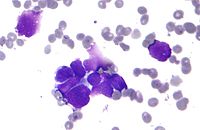
Photo from wikipedia
Background Despite decades of therapeutic trials, effective diagnosis, many drugs available and numerous studies on breast cancer, it remains the deadliest cancer in women. In order to choose the most… Click to show full abstract
Background Despite decades of therapeutic trials, effective diagnosis, many drugs available and numerous studies on breast cancer, it remains the deadliest cancer in women. In order to choose the most appropriate treatment and to understand the prognosis of the patients, breast cancer is divided into different subtypes using a molecular classification. Just as there remains a need to discover new effective therapies, models to test them are also required. Methods The EO771 (also named E0771 or EO 771) murine mammary cancer cell line was originally isolated from a spontaneous tumour in C57BL/6 mouse. Although frequently used, this cell line remains poorly characterized. Therefore, the EO771 phenotype was investigated. The phenotype was compared to that of MCF-7 cells, known to be of luminal A subtype and to express estrogen receptors, as well as MDA-MB-231 cells, which are triple negative. Their sensitivity to hormonal treatment was evaluated by viability tests. Results The EO771 were estrogen receptor α negative, estrogen receptor β positive, progesterone receptor positive and ErbB2 positive. This phenotype was associated with a sensitivity to anti-estrogen treatments such as tamoxifen, 4-hydroxy-tamoxifen, endoxifen and fulvestrant. Conclusions On account of the numerous results published with the EO771 cell line, it is important to know its classification, to facilitate comparisons with corresponding types of tumours in patients. Transcriptomic and protein analysis of the EO771 cell line classified it within the luminal B subtype. Luminal B cancers correspond to one of the subtypes most frequently encountered in patients and associated with a poor prognosis.
Journal Title: Cancer Cell International
Year Published: 2020
Link to full text (if available)
Share on Social Media: Sign Up to like & get
recommendations!